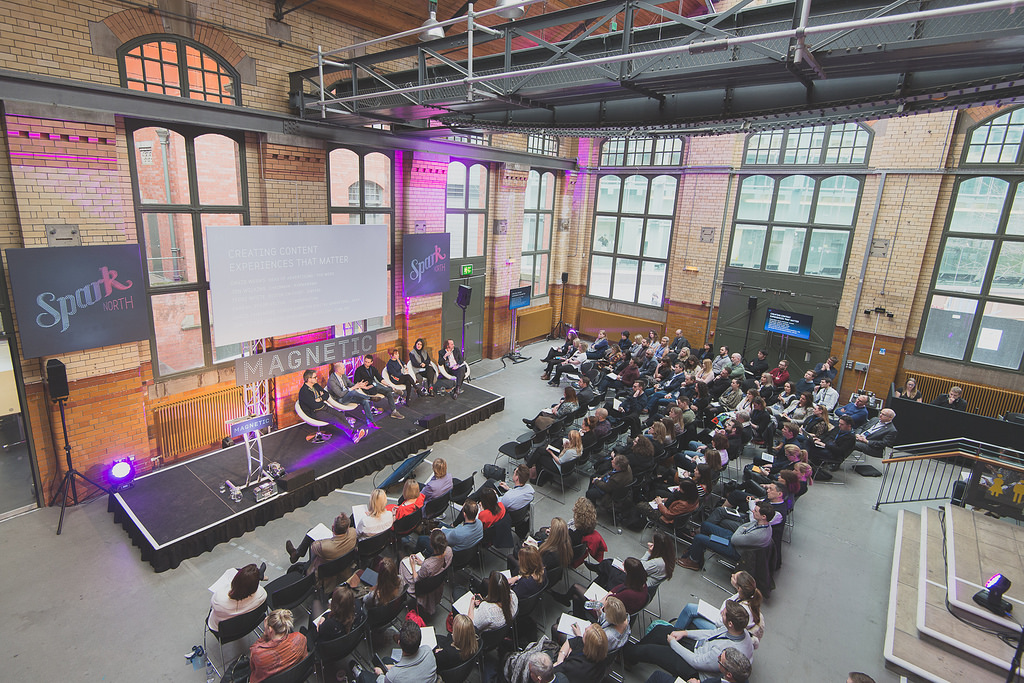On March 10 the media industry gathered in Manchester for Magnetic’s Spark North event.
Framed by the impressive setting of the hall of the People’s History Museum, Sue Todd, the Magnetic chief executive, welcomed the assembled audience with the message that the event would focus on three major themes: Attention, Anxiety, and Advertising Receptivity.
Todd’s weather-related slide, depicting a storm, not above Manchester but the advertising community, represented some of the issues that Spark would address. Notably the “repeated task shifting leading to anxiety” among consumers and the acceleration in the decline of people’s receptivity to advertising.
Spark#1 Moments that matter
Building on Todd’s introduction, Anna Sampson, Magnetic’s head of insight, took to the stage to familiarise the audience with the Moments that Matter research from Magnetic. Placed in the context of the work of Professor Paul Dolan, the behavioural economist, into “happiness theory”, Sampson outlined the key finding of the research: “Magazine media makes you happy because it uniquely satisfies pleasure and purpose, and that creates a welcome environment for advertising.”
Identifying an issue that would define the afternoon, Sampson concluded that magazine media provides a welcome haven “in a challenging marketing environment where we are seeing declining ad receptivity.”
Spark#2 Communications and the brain
The science behind happiness, pleasure, and purpose was explored by Heather Andrew, the chief executive of consultancy Neuro-Insight. Andrew explained how emotion and memory are the key drivers of communications effectiveness and expanded on the role magazine media plays in this.
She explained that our brains have natural, in-built ad blockers that cause us to react badly to “shouty advertising” and react more favourably to subtle, implicit brand cues. “Magazines elicit a strong brain state, they encourage people to sit back, enjoy, be receptive, be happy and then people are receptive to brand messages. We’ve found in research that there’s a huge release when people escape to something more comforting and familiar. This explains why magazines have a huge part to play in the media environment today.”
Spark#3 Content experiences that matter
Next came a panel session, chaired by David Weeks, executive director – head of advertising at The Week. It debated creating content and advertising environments that work for audiences and brands in an era where people are deluged with content and brands struggle to be loved.
The panel discussion concluded with each member naming one vital reason why magazine media will remain strong and credible in the context of declining ad receptivity and growing competition for audience attention.
Terri White, Editor-in-Chief of Empire: “We’re in the age of authenticity. Where content falls down for me is when it’s not authentic – if it is then consumers don’t care where it comes from or who paid for it. If we behave in an authentic, meaningful way then an audience believes us.”
Farrah Storr, Editor, Cosmopolitan: “It’s storytelling that we are experts at. We do this with every bit of information we have, knowing how to make sense of the everyday.”
Jon Wilkins, Chairman, Karmarama: “Magazines provide advice and action. I use magazines to navigate stuff like the music that I’m interested in and help me in how I want to lead my life.”
Chris Chalmers, Senior Director Digital Marketing, Asda: “Commercial merit. We have proven econometric modelling that ties back incremental sales value to our work in magazine media.”
Jon Tickner, Creative Development Director, Time Inc. UK: “We connect to people in special moments, in fulfilling ways that are really valuable.”
Spark#4 The ad receptivity crisis
Kicking off the second session with a gloomy warning was Sue Elms, the EVP global brands at Millward Brown. Elms blamed the advertising industry for a recent significant decline in advertising receptivity, comparing it to climate change: “People are less receptive to advertising and it is our fault. Our behaviours as the ad industry have been more bad than good. We’re belching out our own version of CO2 and this impacting badly on effectiveness.”
Elms called for a “revolution” to address the issue of declining receptivity and also identified the rise of ad blockers as a major cause for concern: “I don’t think it’s an exaggeration to say in three years’ time half the people in UK will be physically closed to advertising and a third mentally.”
However, brands that build strong emotional connections with people will succeed. Elms said: “Consumers are increasingly resistant to advertising intruding into their lives, but receptivity is vital to success. Most of all, we have to walk in consumers’ shoes and find out what they find valuable, deploy this creatively across a range of touchpoints with experiences that they find entertaining and rewarding.”
Spark#5 Should receptivity be the new ‘share of voice’?
The panel, hosted by Dominic Mills, the media commentator and Mediatel journalist, added layers to Sue Elms’ talk on ad receptivity.
Douglas McCabe, the Chief Executive of Enders Analysis, said: “My personal view is that, by and large, it is a digital problem. There are problems in other media but, all things considered, the problems are way bigger in digital environments due to infinite inventory.”
Bob Wootton, the Director of Media and Advertising at ISBA, said: “I’m optimistic because we’ve managed to get onside with this issue and hang people over the abyss and they’re saying ‘oo-eer’ and getting it. The mantra is becoming that we’ll make things as right as we can.”
But, in a world of almost infinite supply of content and of advertising inventory, what chance for magazine media? Amanda Wigginton, the group customer strategy director at Time Inc. UK, said: ““We’re really focused on great content, creating the right context, on creativity and all the knowledge of the consumer we have. It’s as though everybody is on this digital express train and all this great content is passing them by. We need to unite and get out on the track, change the signal and slow things down so that people can enjoy the content.”
The panel concluded by talking about a renaissance in magazine media, provided by the growing importance of important moments for audiences. Douglas McCabe said: “Magazines are in a powerful position because they have a much more targeted audience and have a real purpose in people’s lives. Magazines drive right through the [ad avoidance] problem as they bring together people with shared interests.”
Spark#6 Optimistic for the future
Throughout the afternoon there was talk of the need for “renaissance or revolution” in advertising so it seemed fitting that the conference concluded with a presentation from Sophie Hackford, Director at Wired Consulting, on the next wave of tech developments and their likely impact on communication.
Hackford focused on developments in the on demand economy, AI, and the evolution of space travel. Her remark that “we’re not suffering from a lack of technology but lack of imagination of what to do with it” seemed relevant to much of what had gone before.
Hackford’s optimistic tone – she posed the question about tech “Renaissance or apocalypse?” and sided with the former – proved a fitting way to finish the conference. Then Sue Todd concluded with a reminder that demand for magazine media content is on the rise and emphasised the sector’s determination to deliver “professionally edited, original content that inspires action.”




